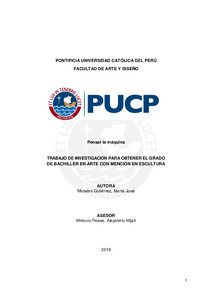| dc.contributor.advisor | Mitrovic Pease, Alejandro Mijail | |
| dc.contributor.author | Morales Gutiérrez, María José | |
| dc.date.accessioned | 2021-03-09T21:03:37Z | |
| dc.date.available | 2021-03-09T21:03:37Z | |
| dc.date.created | 2019 | |
| dc.date.issued | 2021-03-09 | |
| dc.identifier.uri | http://hdl.handle.net/20.500.12404/18533 | |
| dc.description.abstract | El presente trabajo toma como punto de partida la relación entre el medio urbano y el
arte expuesta en los textos situacionistas, en busca de intentar responder preguntas
sobre la construcción de límites concretos y abstractos dentro de la ciudad de Lima.
¿Cómo suena un muro? ¿Puede ser la construcción de límites concretos en la ciudad
un reflejo de su fragmentación y segregación social? ¿Cómo suena la ciudad? ¿Será
posible referirse a esta a través del ruido que emite? A partir de estas interrogantes,
propongo como materia de investigación la influencia de la Internacional Situacionista
en Paris del siglo XIX, donde sus manifiestos y propuestas critican radicalmente la
estructura funcional de modernización, porque suponen segregación social y
fomentan la alienación en sus ciudadanos. El movimiento situacionista,
específicamente el Urbanismo Unitario, se enfoca en combatir el modelo sedentario
funcional, apostando por propuestas como la deriva, la psicogeografía, el juego, entre
otras, como herramientas para despertar al ciudadano de la sociedad de consumo en
que se encuentra. A lo largo de la investigación pongo en cuestionamiento la
posibilidad de enfrentar la enajenación y fragmentación social contemporánea
mediante la producción y apropiación real del individuo con su ciudad. A partir del uso
de deriva como instrumento de reconocimiento cognitivo del espacio, planteo el
ejercicio de realizar derivas sonoras dentro de Lima, registrando los recorridos en
grabaciones y escritos, materia que será clave dentro del desarrollo de la propuesta
artística planteada. | es_ES |
| dc.description.abstract | The following research explores the relationship between the urban environment and
the art exposed in the situationist texts to answer questions about the construction of
concrete and abstract limits within the city of Lima. What does a wall sound like? Can
the construction of concrete boundaries in the city be a reflection of its fragmentation
and social segregation? What does the city sound like? Is it possible to refer to this
through the noise it emits? Based on this questions, the research topic I propose has
to do with the influence of the International Situationist in Paris during the 19th century,
whose manifests and proposals radically criticize the functional structure of
modernization, mainly because they involve social segregation and encourage alienation in its citizens. The Situationist movement, specifically Unitary Urbanism,
focuses on fighting the functional sedentary model through proposals such as “drift”,
psychogeography, play, among others, as tools to awaken the citizen of the consumer
society in which it is located. Throughout the investigation, I question the possibility of
facing the alienation and contemporary social fragmentation through the real
production and appropriation from the individual with his city. Using the drift as an
instrument of cognitive recognition of space, I propose the exercise of carrying out
sound drifts within Lima by registering the routes in recordings and writings, that will
be the foundations for the development of the artistic proposal. | es_ES |
| dc.language.iso | spa | es_ES |
| dc.publisher | Pontificia Universidad Católica del Perú | es_ES |
| dc.rights | info:eu-repo/semantics/openAccess | es_ES |
| dc.rights.uri | http://creativecommons.org/licenses/by-sa/2.5/pe/ | * |
| dc.subject | Arte y sociedad | es_ES |
| dc.subject | Internacional Situacionista | es_ES |
| dc.subject | Sonido en el arte | es_ES |
| dc.subject | Espacio público--Perú--Lima--Siglo XXI | es_ES |
| dc.subject | Urbanismo | es_ES |
| dc.title | Pensar la máquina | es_ES |
| dc.type | info:eu-repo/semantics/bachelorThesis | es_ES |
| thesis.degree.name | Bachiller Arte con mención en Escultura | es_ES |
| thesis.degree.level | Bachillerato | es_ES |
| thesis.degree.grantor | Pontificia Universidad Católica del Perú. Facultad de Arte y Diseño | es_ES |
| thesis.degree.discipline | Arte con mención en Escultura | es_ES |
| renati.advisor.dni | 45953660 | |
| renati.advisor.orcid | https://orcid.org/0000-0002-9232-5472 | es_ES |
| renati.author.dni | 70423051 | |
| renati.discipline | 213256 | es_ES |
| renati.level | https://purl.org/pe-repo/renati/level#bachiller | es_ES |
| renati.type | https://purl.org/pe-repo/renati/type#trabajoDeInvestigacion | es_ES |
| dc.publisher.country | PE | es_ES |
| dc.subject.ocde | https://purl.org/pe-repo/ocde/ford#6.04.00 | es_ES |






